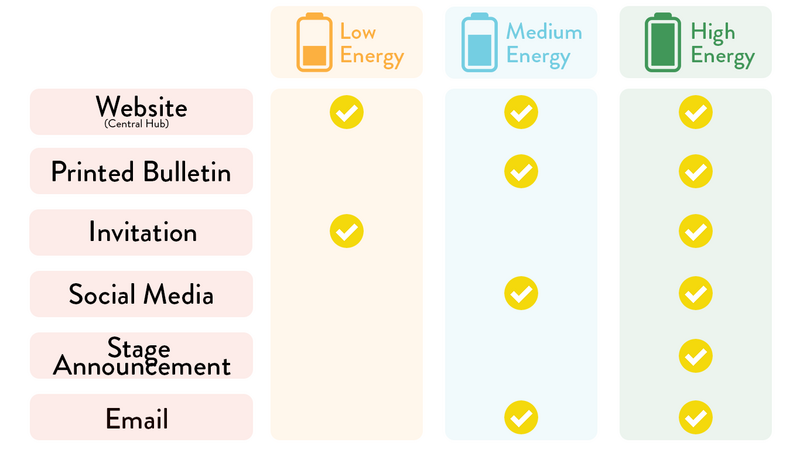Have you ever had someone tell you they didn't know about an event or program—even though it's been in the bulletin for several weeks, someone's talked about it from the stage, and it's been in the weekly email for over a month?
You're not alone.
Many churches struggle to identify the best way to communicate about a wide range of activities and events. The solution in many of these churches often involves communicating everything everywhere. And the results are consistent: people feel disconnected and uninformed.
But how can this be? If we communicate consistently and use the same mediums, shouldn't more people be aware of what's going on? Shouldn't we see greater success?
Why people miss the message
Many churches see excellent results with digital tools like email, with higher open rates and click-through rates than the wider nonprofit industry average or overall averages for these metrics. Why? Church members tend to care about what's happening in the life of their church.
But even though people want to feel connected to their church, the reality is that their lives are still busy, and their church is one of many facets filling out their calendar and lifestyle.
We're all bombarded with more messages than we can remember each day. Advertisements, details, and information come at us from every direction—all vying for our attention.
So, even though your church members want to feel informed and connected to everything happening in the church, we often consume more information than we can process.
Our brains naturally start tuning out information that doesn't directly pertain to us and our needs. So when we read an email or the bulletin and most of it doesn't directly apply to us, we begin to tune out everything in the bulletin—not just those aspects that don't pertain to our lives.
How to beat information overload
As a busy church communicator, it may be easier to put everything everywhere. And, often, the reactionary response to someone saying they didn't know about an activity might be to put everything in more places.
But if you want your communications to connect with people, you must beat information overload. You need to think strategically about connecting with the right people in the right way.
Instead of throwing everything out there and expecting people to pick through to find what is important to them, your role as a church communicator is to help give the right people the right information at the right time. Remember, communication and marketing is all about connecting with people.
And it all starts with having a plan in place.
Navigating the murky marketing waters
Without a communication plan, everything gets announced everywhere—or worse, nowhere. Without a plan, it is easy to overlook an event or announcement for something else that has taken up so much of your time.
But having a plan helps you navigate the murky marketing waters, overcome information overload, and connect with the right people.
Creating a church communications matrix establishes a framework for decision-making—clearing the waters for consistent and effective marketing.
Creating your church communications plan
There are two elements to your church communications plan:
- Your audiences
- A communications matrix
1. Your audience
Knowing your varying audiences is vital to connect your communications to the right people. Creating audience segments—groups of people with similarities—can help you target each communication to the group most likely to connect with it.
2. A communications matrix
Whenever there's an event, program, ministry, or anything to communicate, a church communications matrix provides the framework to identify the right path forward. Start by asking three questions.
- Who does this event apply to?
- How much of my time should go toward this communication?
- What methods would best market this event?
Answering those three questions against your matrix helps you determine the best communication method.
Now, let's talk about the matrix itself.
Church communications matrix: A three-tiered approach
Not every announcement or event should be marketed (or communicated) the same way. Some require more energy, focus, and marketing, while others need to be more targeted to connect with the right audience.
Setting up a three-tiered matrix framework helps you quickly determine how to communicate everything. How you answer the three questions above enables you to decide which tier each piece of communication falls under.
Keeping with the Church Juice theme, we've labeled our tiers based on energy requirements. Here's how a matrix might look:

Your church likely communicates through many more channels, so break down your channels as much as you think is required (for example, you might have organic social media posts and paid social media ads listed separately). Here's how each tier works:
High-Energy Events
A high-energy event is the highest level of communication. It should apply to the entire congregation or at least 80% of your attendees. Everyone, including most of your target audience personas, needs to hear about these events.
Some good examples of high-energy events are Christmas or Easter services, a church-wide initiative, or a major outreach event. Realistically, there should only be a handful (at most) of high-energy events each year.
High-energy events require the most energy from you and the other ministry leaders. They should be promoted and talked about across all of your church's communication methods.
Medium-Energy Events
Most events likely fall into the medium-energy event tier. This applies to many in the church, but not everyone. Generally, this communication applies to between 1/3 and 3/4 of your church.
Communications in this tier include many regular ministry events and programs, such as small group launches, major next steps, and volunteer opportunities.
Medium-energy events can be promoted across some platforms or modes but should focus on where they will be most effective based on the identified target audiences that connect most closely with this event.
Low-Energy Events
The lowest level of a church communicator's investment should go into low-energy events. These communications apply to a small segment of your congregation—less than a third—and are specific to certain crowds or ministries.
For example, a low-energy event might apply to new guests, an upcoming children's event, or a time change for a certain bible study.
Low-energy events should be communicated sparingly and advertised using only the venues that make sense for the announcement and audience.
Setting up your matrix
The first and central aspect of setting up your matrix is to start with one centralized location where people can access information for any event, regardless of the tier a particular communication falls into. Your central place ought to be an easily accessible form of communication that serves as the "central source of truth" and provides the essential details for everything happening in the church. Communication through other channels ought to point back to this central place and be regularly updated and reliable.
After setting your central hub, you can map out your matrix and the varying church communication tiers. Start by listing all of the regular methods you use to communicate. This list should include everything from flyers or handouts to stage announcements to road banners or signs.
After you have a complete list of your regular forms of communication, begin to break down each method of communication for the varying tiers. What modes of communication make the most sense for a small-energy event? Medium? High? Remember, this is a framework, not a policy.
Using your church communications matrix
Whenever a new event or activity is ready for its communication strategy, start by asking your three questions:
- Who does this event apply to?
Which of our target audiences is most likely to connect with this event? How many of our people would like to engage with this event? - How much of my time should go toward this communication?
What else is on the calendar that I need to devote time to? How much time can I afford to spend marketing this event? How much time should I spend on this event? - What methods would best market this event?
With the target audiences in mind, which modes of communication are they most likely to engage with?
After answering your three questions, determine the church communications tier under which this piece falls. Then, use your matrix to determine precisely which modes of communication are most likely to connect with the determined audience.
Not every method needs to be used every time, even though it's within a particular tier. And sometimes, the tools you use may shuffle around a bit. That's okay!
Remember—you're changing church culture. So be patient and understanding, and be slow to make additional changes. Get the necessary people on board and begin to make incremental changes so you can communicate to your people more effectively by breaking through the noise to connect with the right people.
